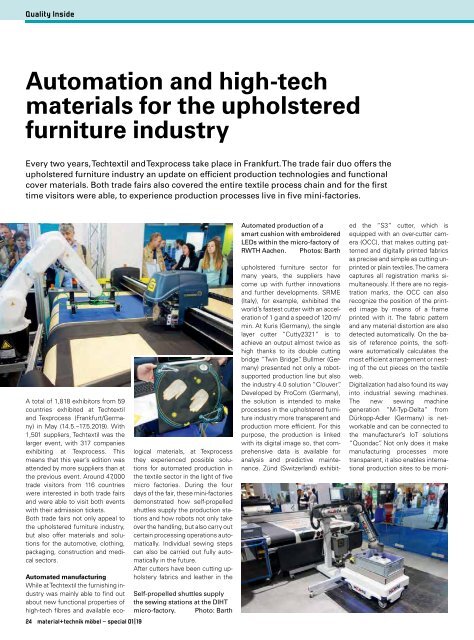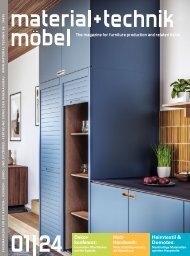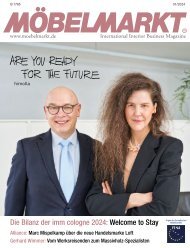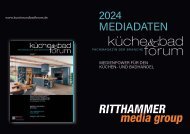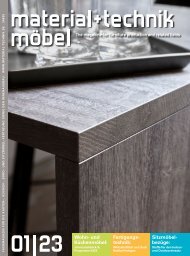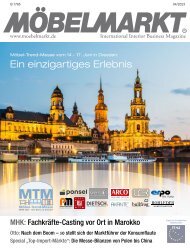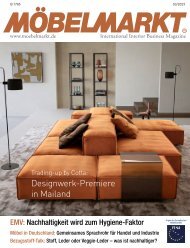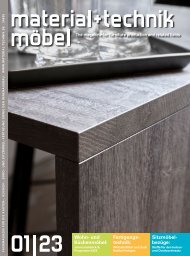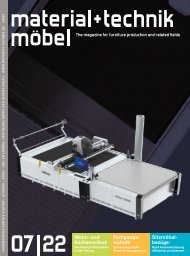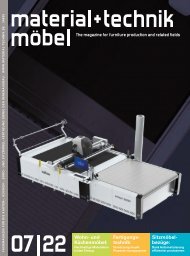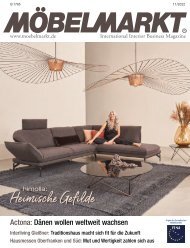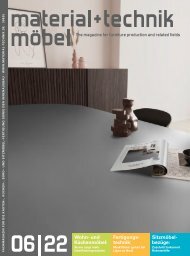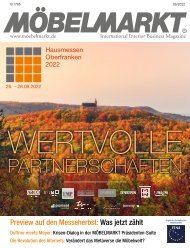Create successful ePaper yourself
Turn your PDF publications into a flip-book with our unique Google optimized e-Paper software.
Quality Inside<br />
Automation and high-tech<br />
materials for the upholstered<br />
furniture industry<br />
Every two years, Techtextil and Texprocess take place in Frankfurt. The trade fair duo offers the<br />
upholstered furniture industry an update on efficient production technologies and functional<br />
cover materials. Both trade fairs also covered the entire textile process chain and for the first<br />
time visitors were able, to experience production processes live in five mini-factories.<br />
A total of 1,818 exhibitors from 59<br />
countries exhibited at Techtextil<br />
and Texprocess (Frankfurt/Germany)<br />
in May (14.5.–17.5.2<strong>01</strong>9). With<br />
1,5<strong>01</strong> suppliers, Techtextil was the<br />
larger event, with 317 companies<br />
exhibiting at Texprocess. This<br />
means that this year’s edition was<br />
attended by more suppliers than at<br />
the previous event. Around 47,000<br />
trade visitors from 116 countries<br />
were interested in both trade fairs<br />
and were able to visit both events<br />
with their admission tickets.<br />
Both trade fairs not only appeal to<br />
the upholstered furniture industry,<br />
but also offer materials and solutions<br />
for the automotive, clothing,<br />
packaging, construction and medical<br />
sectors.<br />
24 material+technik möbel – <strong>special</strong> <strong>01</strong>|19<br />
Automated manufacturing<br />
While at Techtextil the furnishing industry<br />
was mainly able to find out<br />
about new functional properties of<br />
high-tech fibres and available ecological<br />
materials, at Texprocess<br />
they experienced possible solutions<br />
for automated production in<br />
the textile sector in the light of five<br />
micro factories. During the four<br />
days of the fair, these mini-factories<br />
demonstrated how self-propelled<br />
shuttles supply the production stations<br />
and how robots not only take<br />
over the handling, but also carry out<br />
certain processing operations automatically.<br />
Individual sewing steps<br />
can also be carried out fully automatically<br />
in the future.<br />
After cutters have been cutting upholstery<br />
fabrics and leather in the<br />
Self-propelled shuttles supply<br />
the sewing stations at the DIHT<br />
micro-factory. Photo: Barth<br />
Automated production of a<br />
smart cushion with embroidered<br />
LEDs within the micro-factory of<br />
RWTH Aachen. Photos: Barth<br />
upholstered furniture sector for<br />
many years, the suppliers have<br />
come up with further innovations<br />
and further developments. SRME<br />
(Italy), for example, exhibited the<br />
world’s fastest cutter with an acceleration<br />
of 1 g and a speed of 120 m/<br />
min. At Kuris (Germany), the single<br />
layer cutter “Cutty2321” is to<br />
achieve an output almost twice as<br />
high thanks to its double cutting<br />
bridge “Twin Bridge”. Bullmer (Germany)<br />
presented not only a robotsupported<br />
production line but also<br />
the industry 4.0 solution “Clouver”.<br />
Developed by ProCom (Germany),<br />
the solution is intended to make<br />
processes in the upholstered furniture<br />
industry more transparent and<br />
production more efficient. For this<br />
purpose, the production is linked<br />
with its digital image so, that comprehensive<br />
data is available for<br />
analysis and predictive maintenance.<br />
Zünd (Switzerland) exhibited<br />
the “S3” cutter, which is<br />
equipped with an over-cutter camera<br />
(OCC), that makes cutting patterned<br />
and digitally printed fabrics<br />
as precise and simple as cutting unprinted<br />
or plain textiles. The camera<br />
captures all registration marks simultaneously.<br />
If there are no registration<br />
marks, the OCC can also<br />
recognize the position of the printed<br />
image by means of a frame<br />
printed with it. The fabric pattern<br />
and any material distortion are also<br />
detected automatically. On the basis<br />
of reference points, the software<br />
automatically calculates the<br />
most efficient arrangement or nesting<br />
of the cut pieces on the textile<br />
web.<br />
Digitalization had also found its way<br />
into industrial sewing machines.<br />
The new sewing machine<br />
generation “M-Typ-Delta” from<br />
Dürkopp-Adler (Germany) is networkable<br />
and can be connected to<br />
the manufacturer’s IoT solutions<br />
“Quondac”. Not only does it make<br />
manufacturing processes more<br />
transparent, it also enables international<br />
production sites to be moni-


